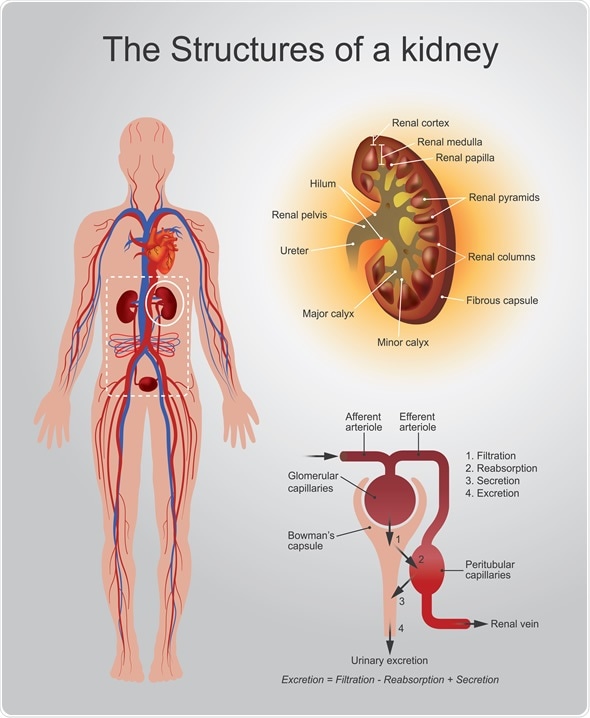Also known as acute renal failure, acute kidney injury (AKI) refers to the sudden loss of excretory kidney function. It is evidenced by the accumulation of toxic metabolic products (urea and creatinine) in the body, by a reduction in the volume of urine not due to extra renal problems or both.
Incidence
AKI occurs in several ways. Based on the various types, the incidence is as follows:
- Prerenal causes – 25-60%
- Renal causes – 35-70%
- Post-renal causes – 5-20%
Among these, ischemic or nephrotoxic insults are responsible for 80-90% of renal causes of AKI.

Signs and Symptoms
Since AKI has to do with a failure of kidney excretion, it is signaled by:
- Increasing levels of nitrogen metabolites in the blood
- Oliguria (production of abnormally small volume of urine) produced by a rapid fall in the glomerular filtration rate due to reduced renal blood flow.
This is not exclusive to intrinsic renal pathology, but may be caused by prerenal conditions such as acute hemorrhage or dehydration; and post-renal causes such as acute urinary tract obstruction.
Types of Acute Kidney Injury
AKI may occur because of damage to any part of the kidney. With reference to site, AKI may be classified as:
- Tubular, namely acute tubular necrosis
- Glomerular, such as acute glomerulonephritis
- Interstitial, as in acute interstitial nephritis
- Vascular, such as that caused by malignant hypertension
Pathophysiology
Acute kidney injury is the manifestation of a variety of clinical conditions, which act through the same pathophysiologic mechanisms, namely:
- Hypoxia
- Ischemia
- Nephrotoxicity
Risk Factors
AKI is common in conditions involving:
- Hypovolemia
- Sepsis
- Pre-existing disease of the heart, kidney or liver
- Hypotension
- Diabetes
- Age
- Exposure to nephrotoxic drugs or agents such as contrast
- Critical illnesses, in which usually renal injury is brought about by sepsis-related changes
AKI occurs in 3-5% of hospitalized patients. An incidence of almost 70% has been reported in ICU patients and 4-5% required renal replacement therapy.
Its importance may be gauged by the fact that hospitalized or ill patients with AKI have a mortality rate which is between 5.5 and 6.5 times higher than in similarly ill patients with normal kidney function – despite the widespread use of dialysis today.
Diagnosis and Treatment
Diagnosis of AKI starts with finding the possible cause, such as drugs or diseases. A physical evaluation, followed by tests of kidney function and tests to identify abnormalities in the urine, is mandatory. Imaging tests are often vital.
Treatment involves finding the cause of the injury, identifying other medical conditions that coexist with the kidney injury, assessing the volume status and correcting it as early as possible with fluids and vasopressors, and using the right measures to correct or arrest renal abnormalities. Careful monitoring is required.
Treatment of acute kidney injury is supportive rather than curative. The kidney function slowly improves as the underlying clinical condition is treated and the toxic products are removed. Nutritional status needs to be monitored and carefully maintained, with a normal glycemic level. Electrolytes and the acid-base levels also must be kept within normal limits.
Renal Replacement Therapy
Renal replacement therapy, or dialysis using cellulose or synthetic membranes, is given if:
- Volume overload is significant
- Biochemical parameters are critically altered
- There is a dangerous buildup of metabolites like urea and creatinine
Prognosis
Even mild AKI increases the risk of death. More than half of AKI patients die, despite renal replacement therapy.
If there is no comorbidity and the kidneys were previously normal, the patient is likely to recover to a point where dialysis is not required. However, 5-50% of patients will need dialysis after their discharge. Patients who are on dialysis are at higher risk of chronic kidney disease, ending in end-stage renal disease.
References
- http://www.ncbi.nlm.nih.gov/pubmed/22617274
- http://www.ncbi.nlm.nih.gov/pubmed/18382185
- http://www.ncbi.nlm.nih.gov/pmc/articles/PMC3919808/
- http://www.ncbi.nlm.nih.gov/pubmed/15232604
- http://www.ncbi.nlm.nih.gov/pubmed/22027404
- http://www.ncbi.nlm.nih.gov/pubmed/18382186
- http://ccforum.biomedcentral.com/articles/10.1186/cc4915
- http://www.ncbi.nlm.nih.gov/pmc/articles/PMC4057151/
- http://europepmc.org/articles/pmc3217737
Further Reading
- All Acute Kidney Injury Content
Last Updated: Feb 26, 2019

Written by
Dr. Liji Thomas
Dr. Liji Thomas is an OB-GYN, who graduated from the Government Medical College, University of Calicut, Kerala, in 2001. Liji practiced as a full-time consultant in obstetrics/gynecology in a private hospital for a few years following her graduation. She has counseled hundreds of patients facing issues from pregnancy-related problems and infertility, and has been in charge of over 2,000 deliveries, striving always to achieve a normal delivery rather than operative.
Source: Read Full Article